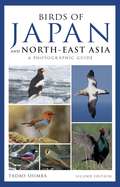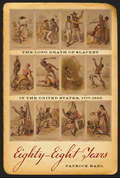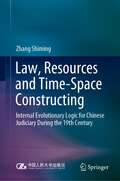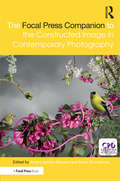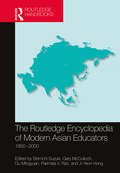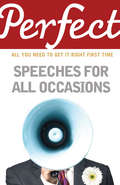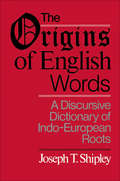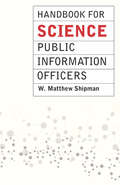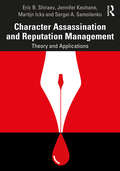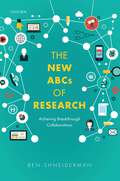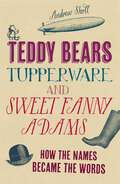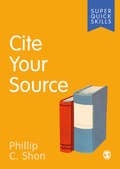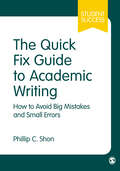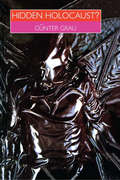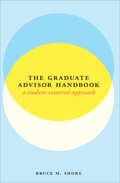- Table View
- List View
Photographic Guide to the Birds of Japan and North-east Asia
by Tadao ShimbaEastern Asia is blessed with a rich and spectacular avifauna, and all 520 regularly occurring species are featured in this spectacular and lavish new photographic guide to the region, covering Japan, northern China, North and South Korea and the Russian Far East. The concise text focuses on key identification criteria, and is accompanied by a distribution map for every species. The accompanying photographs, contributed by Japan's top bird photographers, form a stunning series that will allow both field identification and rich enjoyment at home afterwards. This beautiful book is a must-have for anyone interested in the birds of Asia.
Photographic Guide to the Birds of Japan and North-east Asia: Improvisation And The Theatre (Bloomsbury Revelations Ser.)
by Tadao ShimbaEastern Asia is blessed with a rich and spectacular avifauna, and all 520 regularly occurring species are featured in this spectacular and lavish new photographic guide to the region, covering Japan, northern China, North and South Korea and the Russian Far East. The concise text focuses on key identification criteria, and is accompanied by a distribution map for every species. The accompanying photographs, contributed by Japan's top bird photographers, form a stunning series that will allow both field identification and rich enjoyment at home afterwards. This beautiful book is a must-have for anyone interested in the birds of Asia.
Law, Resources and Time-Space Constructing: Internal Evolutionary Logic for Chinese Judiciary During the 19th Century
by Zhang ShimingThis book studies the judicial evolution of the Qing Dynasty. It sums up the changes from six major aspects: 1. Banfang(班房)emerged in the late Qianlong period; 2. The opening of capital appeals(京控)early in Jiaqing’s reign; 3. The consular jurisdiction was established during Daoguang’s reign; 4. The execution on the spot (就地正法)was started in Daoguang and Xianfeng periods; 5. The introduction of fashenju (发审局,a interrogatory court) happened during Tongzhi’s reign; 6. Late in Guangxu’s reign, banishment was abolished, and reforms were made for prisons. In the past, people did not have a comprehensive understanding of these big changes. From the perspective of legal culture, scholars often criticize traditional Chinese law focuses on criminal law while ignores civil law in terms of legal culture, but this situation can be explained in part by the inadequate allocation of resources and authoritarian resources in traditional societies. Using a large number of archives and precious materials such as private notes that were not noticed by academics in the past, this book adopts the research path of new historical jurisprudence to explore the inner logic of judicial evolution in the Qing Dynasty, focusing on the triangular connection between legal rules, resources, and temporal and spatial constructions, which is an important contribution to the study of traditional Chinese law.
The Focal Press Companion to the Constructed Image in Contemporary Photography
by Marni Shindelman Anne Leighton MassoniThis compendium examines the choices, construction, inclusions and exemptions, and expanded practices involved in the process of creating a photograph. Focusing on work created in the past twenty-five years, this volume is divided into sections that address a separate means of creating photographs as careful constructs: Directing Spaces, Constructing Places, Performing Space, Building Images, and Camera-less Images. Introduced by both a curator and a scholar, each section features contemporary artists in conversation with curators, critics, gallerists, artists, and art historians. The writings include narratives by the artist, writings on their work, and examinations of studio practices. This pioneering book is the first of its kind to explore this topic beyond those artists building sets to photograph.
The Routledge Encyclopedia of Modern Asian Educators: 1850–2000
by Shin’ichi Suzuki; Gary McCulloch; Gu Mingyuan; Parimala V. Rao; Ji-Yeon HongThis handbook is a unique and major resource on modern educators of Asia and their contribution to Asian educational development through the 19th and 20th centuries when modernization started in Asia. In one comprehensive volume, this handbook covers a selection of modern educators from East Asia, South Asia, and Southeast Asia – and their contributions to the development of modern education, practically and theoretically. The diversity of cultures and religion as well as the multilinguistic and ethnic context have made Asian modernization unique and complex. Educational modernization in Asia reflected this historical context in many ways and resulted in the diverse forms of learning, teaching, institutions, and administration. Modern Asian educators compiled in this handbook represent various fields of Asian society: not only educational but cultural and social fields like academia, politics, economics, religion, literature, theatre, fine arts, and civic genres including the media. Through this Handbook, readers may discover the individual modern educators, male and female, and their contributions to Asian educational modernization. All of them were committed to the cause of education for children, youth, adults and in particular women. In addition, this volume has an extraordinarily rich subject index which can be an excellent guide and introduction to information touching divergent dynamics of educational developments in modern Asia. This insightful volume is perfect for students and researchers working on history of education, comparative education and educational development, particularly for those interested in Asian contexts.
Perfect Speeches for All Occasions (The\perfect Ser.)
by Matt ShinnHave you been asked to give a speech?Are you worried your nerves will get the better of you?Do you need some tips on how to deliver your message clearly and effectively?Perfect Speeches for All Occasions is an indispensable guide for anyone who has to give a talk or presentation. Written by Matt Shinn, a professional speech writer with years of experience in the field, it explains how to structure your speech so that it has the most impact and gives practical advice about controlling your nerves on the big day. Whether you're been asked to say a few words at a party or need to put together a high-level presentation, Perfect Speeches for All Occasions has all you need to make sure you perform with style and confidence.The Perfect series is a range of practical guides that give clear and straightforward advice on everything from getting your first job to choosing your baby's name. Written by experienced authors offering tried-and-tested tips, each book contains all you need to get it right first time.
The Origins of English Words: A Discursive Dictionary of Indo-European Roots
by Joseph Twadell ShipleyThere are no direct records of the original Indo-European speech. By comparing the vocabularies of its various descendants, however, it is possible to reconstruct the basic Indo-European roots with considerable confidence. In The Origins of English Words, Shipley catalogues these proposed roots and follows the often devious, always fascinating, process by which some of their offshoots have grown.Anecdotal, eclectic, and always enthusiastic, The Origins of English Words is a diverting expedition beyond linguistics into literature, history, folklore, anthropology, philosophy, and science.
Handbook for Science Public Information Officers (Chicago Guides to Writing, Editing, and Publishing)
by W. Matthew ShipmanWhether sharing a spectacular shot from a deep-space probe, announcing a development in genetic engineering, or crafting an easy-to-reference list of cancer risk factors, science public information officers, or PIOs, serve as scientific liaisons, connecting academic, nonprofit, government, and other research organizations with the public. And as traditional media outlets cut back on their science coverage, PIOs are becoming a vital source for science news. W. Matthew Shipman’s Handbook for Science Public Information Officers covers all aspects of communication strategy and tactics for members of this growing specialty. It includes how to pitch a story, how to train researchers to navigate interviews, how to use social media effectively, and how to respond to a crisis. The handbook offers a wealth of practical advice while teaching science PIOs how to think critically about what they do and how they do it, so that they will be prepared to take advantage of any situation, rather than being overwhelmed by it. For all science communicators—whether they’re starting their careers, crossing over from journalism or the research community, or professional communicators looking to hone their PIO skills—Shipman’s Handbook for Science Public Information Officers will become their go-to reference.
Handbook for Science Public Information Officers (Chicago Guides to Writing, Editing, and Publishing)
by W. Matthew ShipmanWhether sharing a spectacular shot from a deep-space probe, announcing a development in genetic engineering, or crafting an easy-to-reference list of cancer risk factors, science public information officers, or PIOs, serve as scientific liaisons, connecting academic, nonprofit, government, and other research organizations with the public. And as traditional media outlets cut back on their science coverage, PIOs are becoming a vital source for science news. W. Matthew Shipman’s Handbook for Science Public Information Officers covers all aspects of communication strategy and tactics for members of this growing specialty. It includes how to pitch a story, how to train researchers to navigate interviews, how to use social media effectively, and how to respond to a crisis. The handbook offers a wealth of practical advice while teaching science PIOs how to think critically about what they do and how they do it, so that they will be prepared to take advantage of any situation, rather than being overwhelmed by it. For all science communicators—whether they’re starting their careers, crossing over from journalism or the research community, or professional communicators looking to hone their PIO skills—Shipman’s Handbook for Science Public Information Officers will become their go-to reference.
Handbook for Science Public Information Officers (Chicago Guides to Writing, Editing, and Publishing)
by W. Matthew ShipmanWhether sharing a spectacular shot from a deep-space probe, announcing a development in genetic engineering, or crafting an easy-to-reference list of cancer risk factors, science public information officers, or PIOs, serve as scientific liaisons, connecting academic, nonprofit, government, and other research organizations with the public. And as traditional media outlets cut back on their science coverage, PIOs are becoming a vital source for science news. W. Matthew Shipman’s Handbook for Science Public Information Officers covers all aspects of communication strategy and tactics for members of this growing specialty. It includes how to pitch a story, how to train researchers to navigate interviews, how to use social media effectively, and how to respond to a crisis. The handbook offers a wealth of practical advice while teaching science PIOs how to think critically about what they do and how they do it, so that they will be prepared to take advantage of any situation, rather than being overwhelmed by it. For all science communicators—whether they’re starting their careers, crossing over from journalism or the research community, or professional communicators looking to hone their PIO skills—Shipman’s Handbook for Science Public Information Officers will become their go-to reference.
Handbook for Science Public Information Officers (Chicago Guides to Writing, Editing, and Publishing)
by W. Matthew ShipmanWhether sharing a spectacular shot from a deep-space probe, announcing a development in genetic engineering, or crafting an easy-to-reference list of cancer risk factors, science public information officers, or PIOs, serve as scientific liaisons, connecting academic, nonprofit, government, and other research organizations with the public. And as traditional media outlets cut back on their science coverage, PIOs are becoming a vital source for science news. W. Matthew Shipman’s Handbook for Science Public Information Officers covers all aspects of communication strategy and tactics for members of this growing specialty. It includes how to pitch a story, how to train researchers to navigate interviews, how to use social media effectively, and how to respond to a crisis. The handbook offers a wealth of practical advice while teaching science PIOs how to think critically about what they do and how they do it, so that they will be prepared to take advantage of any situation, rather than being overwhelmed by it. For all science communicators—whether they’re starting their careers, crossing over from journalism or the research community, or professional communicators looking to hone their PIO skills—Shipman’s Handbook for Science Public Information Officers will become their go-to reference.
Handbook for Science Public Information Officers (Chicago Guides to Writing, Editing, and Publishing)
by W. Matthew ShipmanWhether sharing a spectacular shot from a deep-space probe, announcing a development in genetic engineering, or crafting an easy-to-reference list of cancer risk factors, science public information officers, or PIOs, serve as scientific liaisons, connecting academic, nonprofit, government, and other research organizations with the public. And as traditional media outlets cut back on their science coverage, PIOs are becoming a vital source for science news. W. Matthew Shipman’s Handbook for Science Public Information Officers covers all aspects of communication strategy and tactics for members of this growing specialty. It includes how to pitch a story, how to train researchers to navigate interviews, how to use social media effectively, and how to respond to a crisis. The handbook offers a wealth of practical advice while teaching science PIOs how to think critically about what they do and how they do it, so that they will be prepared to take advantage of any situation, rather than being overwhelmed by it. For all science communicators—whether they’re starting their careers, crossing over from journalism or the research community, or professional communicators looking to hone their PIO skills—Shipman’s Handbook for Science Public Information Officers will become their go-to reference.
Handbook for Science Public Information Officers (Chicago Guides to Writing, Editing, and Publishing)
by W. Matthew ShipmanWhether sharing a spectacular shot from a deep-space probe, announcing a development in genetic engineering, or crafting an easy-to-reference list of cancer risk factors, science public information officers, or PIOs, serve as scientific liaisons, connecting academic, nonprofit, government, and other research organizations with the public. And as traditional media outlets cut back on their science coverage, PIOs are becoming a vital source for science news. W. Matthew Shipman’s Handbook for Science Public Information Officers covers all aspects of communication strategy and tactics for members of this growing specialty. It includes how to pitch a story, how to train researchers to navigate interviews, how to use social media effectively, and how to respond to a crisis. The handbook offers a wealth of practical advice while teaching science PIOs how to think critically about what they do and how they do it, so that they will be prepared to take advantage of any situation, rather than being overwhelmed by it. For all science communicators—whether they’re starting their careers, crossing over from journalism or the research community, or professional communicators looking to hone their PIO skills—Shipman’s Handbook for Science Public Information Officers will become their go-to reference.
Character Assassination and Reputation Management: Theory and Applications
by Eric B. Shiraev Jennifer Keohane Martijn Icks Sergei A. SamoilenkoThis lively book offers the first comprehensive examination of character assassination. In modern politics as well as in historical times, character attacks abound. Words and images, like psychological weapons, have sullied or destroyed numerous individual reputations. How does character assassination "work" and when or why does it not? Are character attacks getting worse in the age of social media? Why do many people fail when they are under character attack? How should they prevent attacks and defend against them? Moving beyond discussions about corporate reputation management and public relations canons, Character Assassination and Reputation Management is designed to help understand, critically analyze, and effectively defend against such attacks. Written by an international and interdisciplinary team of experts, the book begins with a discussion of theoretical and applied features of the "five pillars" of character assassination: (1) the attacker, (2) the target, (3) the media, (4) the audience, and (5) the context. The remaining chapters present engaging in-depth discussions and case studies suitable for homework and class discussion. These cases include: Historic figures Leaders from modern times Women in politics U.S. presidents World leaders Political autocrats Democratic leaders Scientists Celebrities Featuring an extensive glossary of key terms, critical thinking exercises, and summaries to encourage problem-based learning, Character Assassination and Reputation Management will prove invaluable to the undergraduate and postgraduate students in communication, political science, global affairs, history, sociology, and psychology departments.
Character Assassination and Reputation Management: Theory and Applications
by Eric B. Shiraev Jennifer Keohane Martijn Icks Sergei A. SamoilenkoThis lively book offers the first comprehensive examination of character assassination. In modern politics as well as in historical times, character attacks abound. Words and images, like psychological weapons, have sullied or destroyed numerous individual reputations. How does character assassination "work" and when or why does it not? Are character attacks getting worse in the age of social media? Why do many people fail when they are under character attack? How should they prevent attacks and defend against them? Moving beyond discussions about corporate reputation management and public relations canons, Character Assassination and Reputation Management is designed to help understand, critically analyze, and effectively defend against such attacks. Written by an international and interdisciplinary team of experts, the book begins with a discussion of theoretical and applied features of the "five pillars" of character assassination: (1) the attacker, (2) the target, (3) the media, (4) the audience, and (5) the context. The remaining chapters present engaging in-depth discussions and case studies suitable for homework and class discussion. These cases include: Historic figures Leaders from modern times Women in politics U.S. presidents World leaders Political autocrats Democratic leaders Scientists Celebrities Featuring an extensive glossary of key terms, critical thinking exercises, and summaries to encourage problem-based learning, Character Assassination and Reputation Management will prove invaluable to the undergraduate and postgraduate students in communication, political science, global affairs, history, sociology, and psychology departments.
The New ABCs of Research: Achieving Breakthrough Collaborations
by Ben ShneidermanThe problems we face in the 21st century require innovative thinking from all of us. Be it students, academics, business researchers of government policy makers. Hopes for improving our healthcare, food supply, community safety and environmental sustainability depend on the pervasive application of research solutions. The research heroes who take on the immense problems of our time face bigger than ever challenges, but if they adopt potent guiding principles and effective research lifecycle strategies, they can produce the advances that will enhance the lives of many people. These inspirational research leaders will break free from traditional thinking, disciplinary boundaries, and narrow aspirations. They will be bold innovators and engaged collaborators, who are ready to lead, yet open to new ideas, self-confident, yet empathetic to others. In this book, Ben Shneiderman recognizes the unbounded nature of human creativity, the multiplicative power of teamwork, and the catalytic effects of innovation. He reports on the growing number of initiatives to promote more integrated approaches to research so as to promote the expansion of these efforts. It is meant as a guide to students and junior researchers, as well as a manifesto for senior researchers and policy makers, challenging widely-held beliefs about how applied innovations evolve and how basic breakthroughs are made, and helping to plot the course towards tomorrow's great advancements.
Teddy Bears, Tupperware and Sweet Fanny Adams: How the names became the words
by Andrew ShollWhat's in a name? From Achilles to zeppelin, the words we use in everyday language invoke a cast of historical characters, from figures of ancient legend to modern-day sports stars. But have you ever stopped to wonder how on earth the names became the words we use so often?How, for example, did Italian nationalist leader Giuseppe Garibaldi give his name to something so sweet as a biscuit? Who was the Gordon Bennett whose name has become an expression of surprise or displeasure? And who knew, when Odysseus set off on his ten-year voyage home in Homer's epic, that long journeys would take his name?Behind so many words are real people with a story to tell. This fascinating book reveals the history behind the most familiar and more unusual eponyms.
Cite Your Source (Super Quick Skills)
by Dr. Phillip C. ShonConfused by citations and referencing? Cite Your Source helps you master the essentials, giving you the know-how to reference your writing with confidence. Understand the importance of citing (and getting it right) Pick up tips on how to avoid unintentional plagiarism Get to grips with different referencing styles. Super Quick Skills provide the essential building blocks you need to succeed at university - fast. Packed with practical, positive advice on core academic and life skills, you’ll discover focused tips and strategies to use straight away. Whether it’s writing great essays, understanding referencing or managing your wellbeing, find out how to build good habits and progress your skills throughout your studies. Learn core skills quickly Apply right away and see results Succeed in your studies and life. Super Quick Skills give you the foundations you need to confidently navigate the ups and downs of university life.
Cite Your Source (Super Quick Skills)
by Dr. Phillip C. ShonConfused by citations and referencing? Cite Your Source helps you master the essentials, giving you the know-how to reference your writing with confidence. Understand the importance of citing (and getting it right) Pick up tips on how to avoid unintentional plagiarism Get to grips with different referencing styles. Super Quick Skills provide the essential building blocks you need to succeed at university - fast. Packed with practical, positive advice on core academic and life skills, you’ll discover focused tips and strategies to use straight away. Whether it’s writing great essays, understanding referencing or managing your wellbeing, find out how to build good habits and progress your skills throughout your studies. Learn core skills quickly Apply right away and see results Succeed in your studies and life. Super Quick Skills give you the foundations you need to confidently navigate the ups and downs of university life.
The Quick Fix Guide to Academic Writing: How to Avoid Big Mistakes and Small Errors (SAGE Study Skills Series)
by Dr Phillip C. ShonWhether you’re writing a paper, essay, assignment, or dissertation, this short and punchy book helps you improve your writing skills through minimal effort. Providing you with a quick set of writing rules to follow, this tried and tested guide uses a unique and easy to follow grid-based system. Packed with advice on understanding (big and little) common errors made in academic writing, it helps you identify patterns in your own writing and demonstrates how to reshape or re-evaluate them - and raise your writing game in any academic context. How-to tutorials include: Synthesizing and critiquing literature – and using your coding sheet to develop critical arguments Shaping abstracts, introductions, discussions, and conclusions – to improve the logic and structure of your writing Applying lessons-learned to future projects, whatever format of academic writing. Save time and improve your grades, with this essential quick fix guide! SAGE Study Skills are essential study guides for students of all levels. From how to write great essays and succeeding at university, to writing your undergraduate dissertation and doing postgraduate research, SAGE Study Skills help you get the best from your time at university. Visit the SAGE Study Skills hub for tips, resources and videos on study success!
The Quick Fix Guide to Academic Writing: How to Avoid Big Mistakes and Small Errors (PDF) (Student Success)
by Phillip C. ShonLecturers request your electronic inspection copy here Whether you’re writing a paper, essay, assignment, or dissertation, this short and punchy book helps you improve your writing skills through minimal effort. Providing you with a quick set of writing rules to follow, this tried and tested guide uses a unique and easy to follow grid-based system. Packed with advice on understanding (big and little) common errors made in academic writing, it helps you identify patterns in your own writing and demonstrates how to reshape or re-evaluate them - and raise your writing game in any academic context. How-to tutorials include: Synthesizing and critiquing literature – and using your coding sheet to develop critical arguments Shaping abstracts, introductions, discussions, and conclusions – to improve the logic and structure of your writing Applying lessons-learned to future projects, whatever format of academic writing. Save time and improve your grades, with this essential quick fix guide! SAGE Study Skills are essential study guides for students of all levels. From how to write great essays and succeeding at university, to writing your undergraduate dissertation and doing postgraduate research, SAGE Study Skills help you get the best from your time at university. Visit the SAGE Study Skills hub for tips, resources and videos on study success!
The Hidden Holocaust?: Gay and Lesbian Persecution in Germany 1933-45
by Claudia Shoppmann Günter GrauThe persecution of lesbians and gay men by the Nazis is a subject that has been constantly debated during the last decade, providing a theme for books, articles, and plays. Until recently the discussion has remained speculative: most of the relevant documents were stored in closed East German archives, and access was denied to scholars and researchers.As a result of the unification of East and West Germany, these archives are now open. Hidden Holocaust, by the German scholars Gunter Grau and Claudia Shoppmann of Humboldt Uinversity, Berlin, demonstrates that the eradication of homosexuals was a declared gol of the Nazis even before they took power in 1933, and provide proof of the systematic anti-gay campaigns, the methods used tjo justify discrimination, and the incarceration mutilation and murder of gay men and women in Nazi concentration camps. A chilling but groud-breaking work in gay and lesbian studies.
The Graduate Advisor Handbook: A Student-Centered Approach (Chicago Guides to Academic Life)
by Bruce M. ShoreIn the sink-or-swim world of academia, a great graduate advising can be a lifesaver. But with university budgets shrinking and free time evaporating, advisors often need a mentor themselves to learn how to best support their advisees. Bruce M. Shore, an award-winning advisor with more than forty years of advising experience, is just the coach that graduate advisors need. With The Graduate Advisor Handbook: A Student-Centered Approach, Shore demystifies the advisor-student relationship, providing tips and practical advice that will help both students and advisors thrive. One of the first books to approach advising from the advisor’s point of view, the handbook highlights the importance of a partnership in which both parties need to be invested. Shore emphasizes the interpersonal relationships at the heart of advising and reveals how advisors can draw on their own strengths to create a rewarding rapport. The Graduate Advisor Handbook moves chronologically through the advising process, from the first knock on the door to the last reference letter. Along the way it covers transparent communication, effective motivation, and cooperative troubleshooting. Its clear-eyed approach also tackles touchy subjects, including what to do when personal boundaries are crossed and how to deliver difficult news. Sample scripts help advisors find the right words for even the toughest situations. With resources dwindling and student and advising loads increasing, graduate advisors need all the resources they can find to give their students the help they need. The Graduate Advisor Handbook has the cool-headed advice and comprehensive coverage that advisors need to make the advising relationship not just effective but also enjoyable.
The Graduate Advisor Handbook: A Student-Centered Approach (Chicago Guides to Academic Life)
by Bruce M. ShoreIn the sink-or-swim world of academia, a great graduate advising can be a lifesaver. But with university budgets shrinking and free time evaporating, advisors often need a mentor themselves to learn how to best support their advisees. Bruce M. Shore, an award-winning advisor with more than forty years of advising experience, is just the coach that graduate advisors need. With The Graduate Advisor Handbook: A Student-Centered Approach, Shore demystifies the advisor-student relationship, providing tips and practical advice that will help both students and advisors thrive. One of the first books to approach advising from the advisor’s point of view, the handbook highlights the importance of a partnership in which both parties need to be invested. Shore emphasizes the interpersonal relationships at the heart of advising and reveals how advisors can draw on their own strengths to create a rewarding rapport. The Graduate Advisor Handbook moves chronologically through the advising process, from the first knock on the door to the last reference letter. Along the way it covers transparent communication, effective motivation, and cooperative troubleshooting. Its clear-eyed approach also tackles touchy subjects, including what to do when personal boundaries are crossed and how to deliver difficult news. Sample scripts help advisors find the right words for even the toughest situations. With resources dwindling and student and advising loads increasing, graduate advisors need all the resources they can find to give their students the help they need. The Graduate Advisor Handbook has the cool-headed advice and comprehensive coverage that advisors need to make the advising relationship not just effective but also enjoyable.
The Graduate Advisor Handbook: A Student-Centered Approach (Chicago Guides to Academic Life)
by Bruce M. ShoreIn the sink-or-swim world of academia, a great graduate advising can be a lifesaver. But with university budgets shrinking and free time evaporating, advisors often need a mentor themselves to learn how to best support their advisees. Bruce M. Shore, an award-winning advisor with more than forty years of advising experience, is just the coach that graduate advisors need. With The Graduate Advisor Handbook: A Student-Centered Approach, Shore demystifies the advisor-student relationship, providing tips and practical advice that will help both students and advisors thrive. One of the first books to approach advising from the advisor’s point of view, the handbook highlights the importance of a partnership in which both parties need to be invested. Shore emphasizes the interpersonal relationships at the heart of advising and reveals how advisors can draw on their own strengths to create a rewarding rapport. The Graduate Advisor Handbook moves chronologically through the advising process, from the first knock on the door to the last reference letter. Along the way it covers transparent communication, effective motivation, and cooperative troubleshooting. Its clear-eyed approach also tackles touchy subjects, including what to do when personal boundaries are crossed and how to deliver difficult news. Sample scripts help advisors find the right words for even the toughest situations. With resources dwindling and student and advising loads increasing, graduate advisors need all the resources they can find to give their students the help they need. The Graduate Advisor Handbook has the cool-headed advice and comprehensive coverage that advisors need to make the advising relationship not just effective but also enjoyable.
